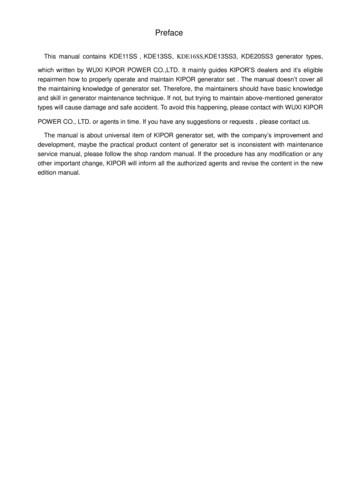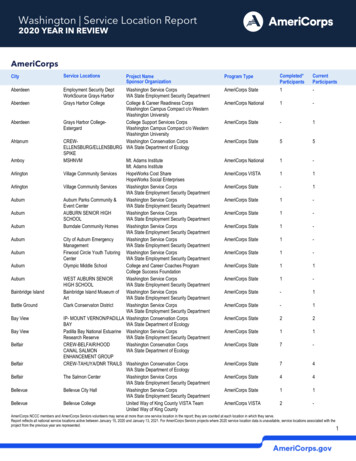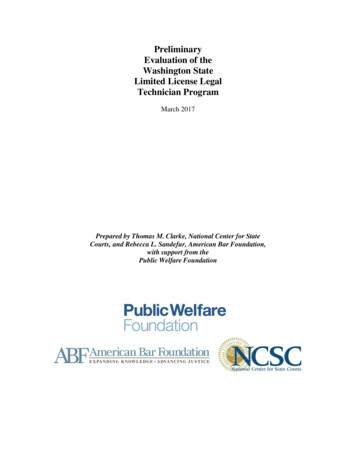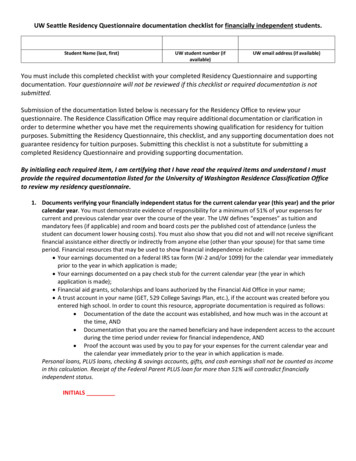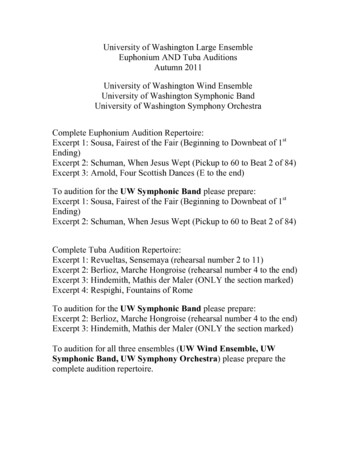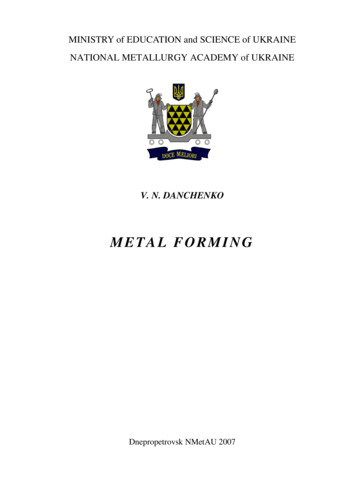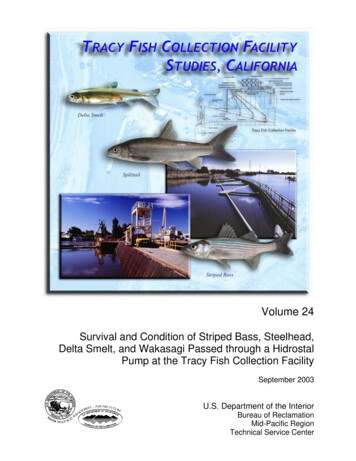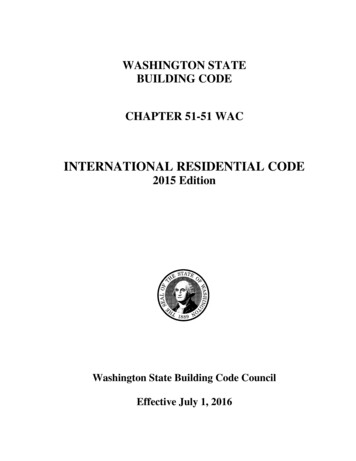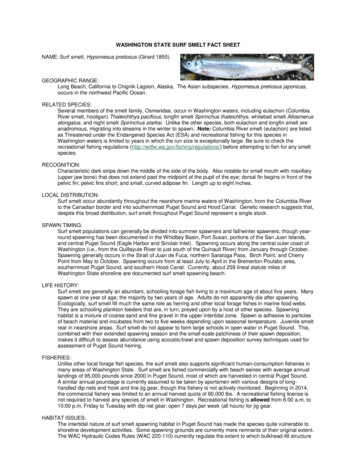
Transcription
WASHINGTON STATE SURF SMELT FACT SHEETNAME: Surf smelt, Hypomesus pretiosus (Girard 1855).GEOGRAPHIC RANGE:Long Beach, California to Chignik Lagoon, Alaska. The Asian subspecies, Hypomesus pretiosus japonicas,occurs in the northwest Pacific Ocean.RELATED SPECIES:Several members of the smelt family, Osmeridae, occur in Washington waters, including eulachon (ColumbiaRiver smelt, hooligan) Thaleichthys pacificus, longfin smelt Spirinchus thaleichthys, whitebait smelt Allosmeruselongatus, and night smelt Spirinchus starksi. Unlike the other species, both eulachon and longfin smelt areanadromous, migrating into streams in the winter to spawn. Note: Columbia River smelt (eulachon) are listedas Threatened under the Endangered Species Act (ESA) and recreational fishing for this species inWashington waters is limited to years in which the run size is exceptionally large. Be sure to check therecreational fishing regulations (http://wdfw.wa.gov/fishing/regulations/) before attempting to fish for any smeltspecies.RECOGNITION:Characteristic dark stripe down the middle of the side of the body. Also notable for small mouth with maxillary(upper jaw bone) that does not extend past the midpoint of the pupil of the eye; dorsal fin begins in front of thepelvic fin; pelvic fins short; and small, curved adipose fin. Length up to eight inches.LOCAL DISTRIBUTION:Surf smelt occur abundantly throughout the nearshore marine waters of Washington, from the Columbia Riverto the Canadian border and into southernmost Puget Sound and Hood Canal. Genetic research suggests that,despite this broad distribution, surf smelt throughout Puget Sound represent a single stock.SPAWN TIMING:Surf smelt populations can generally be divided into summer spawners and fall/winter spawners, though yearround spawning has been documented in the Whidbey Basin, Port Susan, portions of the San Juan Islands,and central Puget Sound (Eagle Harbor and Sinclair Inlet). Spawning occurs along the central outer coast ofWashington (i.e., from the Quillayute River to just south of the Quinault River) from January through October.Spawning generally occurs in the Strait of Juan de Fuca, northern Saratoga Pass, Birch Point, and CherryPoint from May to October. Spawning occurs from at least July to April in the Bremerton-Poulsbo area,southernmost Puget Sound, and southern Hood Canal. Currently, about 259 lineal statute miles ofWashington State shoreline are documented surf smelt spawning beach.LIFE HISTORY:Surf smelt are generally an abundant, schooling forage fish living to a maximum age of about five years. Manyspawn at one year of age; the majority by two years of age. Adults do not apparently die after spawning.Ecologically, surf smelt fill much the same role as herring and other local forage fishes in marine food webs.They are schooling plankton feeders that are, in turn, preyed upon by a host of other species. Spawninghabitat is a mixture of coarse sand and fine gravel in the upper intertidal zone. Spawn is adhesive to particlesof beach material and incubates from two to five weeks depending upon seasonal temperature. Juvenile smeltrear in nearshore areas. Surf smelt do not appear to form large schools in open water in Puget Sound. This,combined with their extended spawning season and the small-scale patchiness of their spawn deposition,makes it difficult to assess abundance using acoustic/trawl and spawn deposition survey techniques used forassessment of Puget Sound herring.FISHERIES:Unlike other local forage fish species, the surf smelt also supports significant human-consumption fisheries inmany areas of Washington State. Surf smelt are fished commercially with beach seines with average annuallandings of 95,000 pounds since 2000 in Puget Sound, most of which are harvested in central Puget Sound.A similar annual poundage is currently assumed to be taken by sportsmen with various designs of longhandled dip nets and hook and line jig gear, though this fishery is not actively monitored. Beginning in 2014,the commercial fishery was limited to an annual harvest quota of 60,000 lbs. A recreational fishing license isnot required to harvest any species of smelt in Washington. Recreational fishing is allowed from 6:00 a.m. to10:00 p.m. Friday to Tuesday with dip net gear; open 7 days per week (all hours) for jig gear.HABITAT ISSUES:The intertidal nature of surf smelt spawning habitat in Puget Sound has made the species quite vulnerable toshoreline development activities. Some spawning grounds are currently mere remnants of their original extent.The WAC Hydraulic Codes Rules (WAC 220-110) currently regulate the extent to which bulkhead-fill structure
can intrude seaward of the high tide line on known smelt spawning beaches and specific seasons during whichadmissible work can be undertaken.QUESTIONS: Contact WDFW Forage Fish Unit, La Conner District Office @ 360-466-4345 x 243.
SURF SMELT SPORT FISHING AREASHAND DIP NET- Various regional designs for gear. Usually early-morning or late evening high-slack tides are moresuccessful. Occurs from shore as fish move into shallow water to spawn. Most smelt beaches areprivately owned -- respect private property.JIGGING-No particular tide more successful, perhaps mornings or evenings are more successful. Herringare usually also available. Usually involves fishing off docks or pier structures on o Spit Co. Pk.July-JanBeaches around and south of the headquarters buildings at thebase of the spit on the west (outer) shore. May be a yearround spawning stockFIDALGO ISLANDFidalgo Bay – March Pt.May-SeptDip netting around perimeter of Fidalgo Bay and at March Pt.Tommy Thompson TrailMay-SeptDip netting along trail, north of Fidalgo Bay Resort/RV park.LACONNER WATERFRONTOct. – MarchJigging off float. Best jigging in the northern boat basin.Annual Smelt Derby in February.SAN JUAN ISLANDSHunter Bay Co. Pk. Lopez Is.Year-roundDip netting on the DNR public beach immediately east of theCounty Park boat launch.WHIDBEY ISLANDCoupeville WaterfrontJune – OctDip netting. Coupeville waterfront and areas to the east,mostly boat access.Deception Pass State ParkYear roundJigging off floats just west of Cornet Bay boat ramp. Lots ofparking and bathroom facilities.Oak Harbor MarinaYear-roundJigging from F-dock.CAMANO ISLANDMaple Grove County ParkUtsalady County ParkJune – OctDip netting. Access at Utsalady and Maple Grove boat ramps.Cavelero Beach County ParkJune – OctDip netting.LIBERTY BAYPoulsboOct – FebDip netting. Small spots at the southern edge of town.Contact the North Kitsap Marine Environmental Center. Mostlyprivate, poor parking.DYES INLETElwood Point Rec. AreaSilverdale City ParkOct – JanDip netting. Relatively unknown accesses.SINCLAIR INLETRoss PointOct – FebDip netting. WDFW purchased public smelt beach. One milewest of the town of Port Orchard. Limited parking and nofacilities. Some smelt spawning occurs year round at this site.QUARTERMASTER HARBORBurton Acres Co. Pk.Oct – FebDip netting. North side of the point to the launch ramp.GIG HARBOROct – MarchPossible dip netting on the beach fronting the launch ramp atRandell Dr NW.
SOUTH SOUNDPercival Landing, OlympiaWinterOccasional concentrations of smelt and herring taken whilejigging and dip netting.Priest Point Park, OlympiaBurfoot Co. Pk. Budd InletSept – FebDip netting. Probably other little known spots among themany miles of spawning beach in Henderson, Budd, Eld andTotten Inlets.Penrose Pt. St Pk, Carr InletOct – MarchPossible Dip netting on the pea-gravel beach around the dayuse picnic area. Potential jig fisheries off the docks inside theharbor.HOOD CANALAll waters south of the Hood Canal Bridge are closed year-round to allsmelt harvest.SEQUIM BAYJohn Wayne MarinaWinterJigging. Reported dense concentrations of surf smelt.DUNGENESS BAYCline SpitOct – JanDip netting. Beaches around the launch ramps and on thesouth shore of the spit.PORT ANGELESP.A. Boat HavenWinterJigging. Occasional concentrations of smelt in the boat basin.May – SeptDip netting. East of the mouth of Deep Creek, at the East andWest Twin Rivers and at Clallam Bay. Largely private.May – SeptDipping in high surf. The area north of Kalaloch is the mostpopular.CLALLAM BAYDeep CreekTwin RiversOCEAN COASTRialto Beach (N. Lapush)Ruby BeachAccesses #4 & #6 (N. Kalaloch)Surf smelt spawn has been found at the Washington State beach parks and public access beaches listedbelow, with presently unknown sport fishery potential:San Juan IslandsDNR Beach 260 (Shaw Island)Cattle Pt. DNR Beach (San Juan Island)English Camp Nat’l Hist. Pk. (San Juan Island)E. Mudd Bay St. Pk. Tidelands (Lopez Island)Canadian Boarder to EverettLighthouse Co. Pk. (Anacortes)Kayak Pt. Co. Pk.Camano IslandCamano Island St. Pk.Hope Island St. Pk. (N. Skagit Bay)Kitsap PeninsulaSuquamish Public rampS. Illahee St. Pk.Randall Street launch ramp (Gig Harbor)Outer CoastNorth Jetty Access (Ocean Shores)Westport Lighthouse St. Pk.Strait of Juan de FucaOld Fort Port Townsend St. Pk.Fidalgo and Whidbey IslandSouth Harbor Pk. (Anacortes)E. Hoypus Pt. (Deception Pass St. Pk.)DNR Beach 144 (N. Whidbey Island)Freeland Co. Pk. (Holmes Harbor)Everett to TacomaBrackett Landing Pk. (Edmonds)Richmond Beach Co. Pk.Alki Beach Pk. (West Seattle)Lincoln Park (West Seattle)Seahurst Park (Des Moines)Brown’s Point Park (Tacoma)South SoundPenrose Pt. St. Pk.Jarrell’s Cove St. Pk.Stretch Island St. Pk.Allyn Public ramp
Personal Use Smelt RegulationsWAC 220-56-240 - Daily limits forage fish and other food fish not otherwise provided forIt is unlawful for any person to retain more than the following quantities and sizes of food fish taken forpersonal use. Unless otherwise provided, other food fish fishing is open the entire year:(1) Forage fish (including surf smelt, herring, anchovy, sand lance, and sardine): 10 pounds in theaggregate. The possession limit is two daily limits in fresh form. Additional forage fish may be possessed infrozen or processed form. No harvest of Columbia River smelt (eulachon) allowed.WAC 220-56-265 Forage fish - Lawful gear(1) It shall be unlawful to take, fish for and possess herring, candlefish, pilchards, anchovies and smelttaken for personal use except with hand dip net gear not exceeding 36 inches across the bag frame havinga maximum mesh size of five-eighths inch stretched mesh size, and forage fish jigger gear having not morethan three treble or nine single hooks.(2) It is unlawful to use a dip bag net to take forage fish unless the operator of the net holds the handle atall times the netting is in the water.(3) It is unlawful to operate a dip bag net to harvest forage fish from a vessel under power, or to use morethan one forage fish dip net at a time.(4) Only persons with a reduced fee license or a designated harvest card may use a hand-operated gateon a dip net while fishing for forage fish.(5) Forage fish jigger gear hooks may not have a gap between the shank and the point exceeding 3/8inch.(6) Use of gear in violation of this section is an infraction, punishable under RCW 77.15.160.(7) It is unlawful to possess forage fish taken with gear in violation of the provisions of this section.Possession of forage fish while using gear in violation of the provisions of this section is a rebuttablepresumption that the forage fish were taken with such gear. Violation of this subsection is punishable underRCW 77.15.380 Unlawful recreational fishing in the second degree -- Penalty, unless the forage fish aretaken in the amounts or manner to constitute a violation of RCW 77.15.370 Unlawful recreational fishing inthe first degree -- Penalty.WAC 220-56-107 - Fishing hours.(2) It is unlawful to fish for the following species during the following times and within the following areas:(d) It is unlawful to fish for smelt in Puget Sound from 10:00 p.m. to 6:00 a.m. unless theperson fishes for smelt using forage fish jig gear.WAC 220-56-270 Smelt - Areas and seasons(1) Unlawful to fish for or possess Columbia River smelt or eulachon (Thaleichthys pacificus).(2) Fishing for smelt other than Columbia River smelt or eulachon (Thaleichthys pacificus) is permitted theentire year on Pacific Ocean beaches and in all rivers concurrent with a salmon or gamefish opening,except closed in the Columbia River and tributaries.(3) Fishing for smelt other than Columbia River smelt or eulachon (Thaleichthys pacificus) is open in PugetSound and the Strait of Juan de Fuca year-round except:(a) Closed weekly from 10:00 p.m. Tuesday to 6:00 a.m. Friday for all gear types except foragefish jig gear; and(b) Closed year-round in Catch Record Card Area 12 for all gear types.(c) Violation of this subsection is an infraction, punishable under RCW 77.15.160.(4) It is unlawful to possess smelt taken with gear in violation of the provisions of this section. Possessionof smelt while using gear in violation of the provisions of this section is a rebuttable presumption that thesmelt were taken with such gear. Possession of such smelt is punishable under RCW 77.15.380
Unlawful recreational fishing in the second degree -- Penalty, unless the smelt are taken in the amountsor manner to constitute a violation of RCW 77.15.370 Unlawful recreational fishing in the first degree -Penalty.WAC 220-56-275 Smelt — Unlawful actsIt shall be unlawful for any person taking smelt for personal use to fail to retain all smelt caught up to thedaily limit.WAC 220-56-115 Angling gear — Lawful and unlawful acts(1) It is unlawful for any person to use more than one line while angling for personal use except:A second line using forage fish jigger gear is lawful while fishing in Catch Record Card Areas 5, 6, 7, 81, 8-2, 9, 10, 11, and 13. A violation of this subsection is an infraction, punishable under RCW77.15.160.WAC 220-56-150 Unlawful to take another's limitIt is unlawful for any person to catch, dig or possess fish or shellfish for another person except designatedharvesters as provided in WAC 220-55-065.WAC 220-56-110 Possession of personal-use food fish and shellfish(5) It shall be unlawful for any person taking food fish or shellfish for personal use to intermingle his catch orpart of his catch with that of any duly licensed person taking food fish or shellfish for commercial purposesexcept for commercially caught fish retained for personal use as provided for in WAC 220-20-016 and 22020-021.
Surf smelt, Hypomesus pretiosusMean High Water LineLast High Tide LineZone of Surf Smelt Spawning HabitatTypical Surf Smelt Spawning Beach, Semiahmoo Bay, WA (Photo By: Dan Penttila - WDFW, 1992)
WASHINGTON STATE SURF SMELT FACT SHEET NAME: Surf smelt, Hypomesus pretiosus (Girard 1855). GEOGRAPHIC RANGE: Long Beach, California to Chignik Lagoon, Alaska. The Asian subspecies, Hypomesus pr
